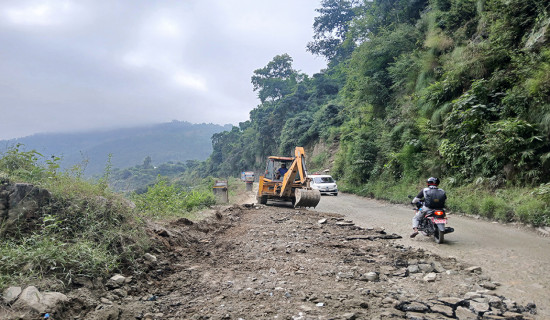- Monday, 8 December 2025
Time-tested Nepali methods to preserve food
By Aaj Jyoti, Kathmandu, Aug. 15: Pickles are considered an integral part of Nepali cuisine. But what else in a Nepali dish is preserved? And why does the process of preservation continue into the modern age?
Sukuti (dried meat), achaar (pickle), gundruk (dried green vegetables) and titaura (seasoned dried fruit) are a few examples of preserved foodstuffs common in Nepali households. The culture of preservation is one that has been carried on for centuries. Preservation can be done in many ways, but mostly by means of bacteria culture within the food to keep it from rotting.
Achaars are probiotic, mostly due to the bacterium lactobacillus, which is also present in gundruk. Its probiotic quality is also beneficial to health, as it balances and maintains gut flora.
Nepali achaars are used to preserve vegetables, fruits and meats, making it a greatly varying condiment. Oils, brine or vinegar is mixed with local spices to flavour fresh produce, usually adding a spicy and tangy kick to a plate of daal bhat. Recently, stores have begun selling a variety of achaars, and are mostly operated by women. Aama ko Achar is one of the most popular retailers, and their website states the Red Chilli, Timur and Garlic Achar as their current best-selling pickle. They sell 200gm jars for around Rs. 200 each, and offer a range of around eight different tastes.
Another common way of preserving is by dehydrating. The method originated in Nepal, but is also made in various parts of Himalayan India and Tibet. Sukuti is most commonly made of buffalo and goat meat, but can also be found as deer meat. This snack has been used as a nutrient source in the mountainous regions of Nepal, during times when fresh meat or other protein is unavailable. It is mainly prepared by thinly slicing meat and hanging it above wooden fires, allowing the smoke to dry the meat. Sukuti is often cooked into a curry, served warm to beat the colder winters. Sukuti can be purchased in packs of 90 grams to bags weighing kilos.
Gundruk is a national dish of Nepal. The dried vegetable is often marinated or consumed as a soup. Annually, Nepali households produce around 2,000 tonnes of gundruk, made mainly of dried leafy vegetables and radish. When leafy vegetables are harvested around October and November, the surplus is left to wilt. After they have wilted, they are packed into clay pots, or plastic jars more recently, to allow them to wilt further and ferment with water. The fermentation process is complete when the pH of the vegetables reaches 4.0, allowing the taste to be acidic and sour. Dehydrating the vegetables preserves the nutrition and minerals found in the fresh vegetables, such as potassium and calcium.
Titaura is a commonly enjoyed snack in Nepal, usually spicy, sweet and sour. These are made using a variety of fruits, such as lapsi (hog plum), mango and amala (gooseberry). The texture of titaura varies according to the type, found as liquids, paperlike sheets or lumps of fruit. The treat is made by preparing ripe fruits by boiling in salt water, before grinding the pulp and seasoning, creating a treat able to be enjoyed in every flavour profile.
Along with these foods, Nepalis have developed numerous other recipes with preserved and dehydrated foods, making up a large percentage of Nepali meals.














